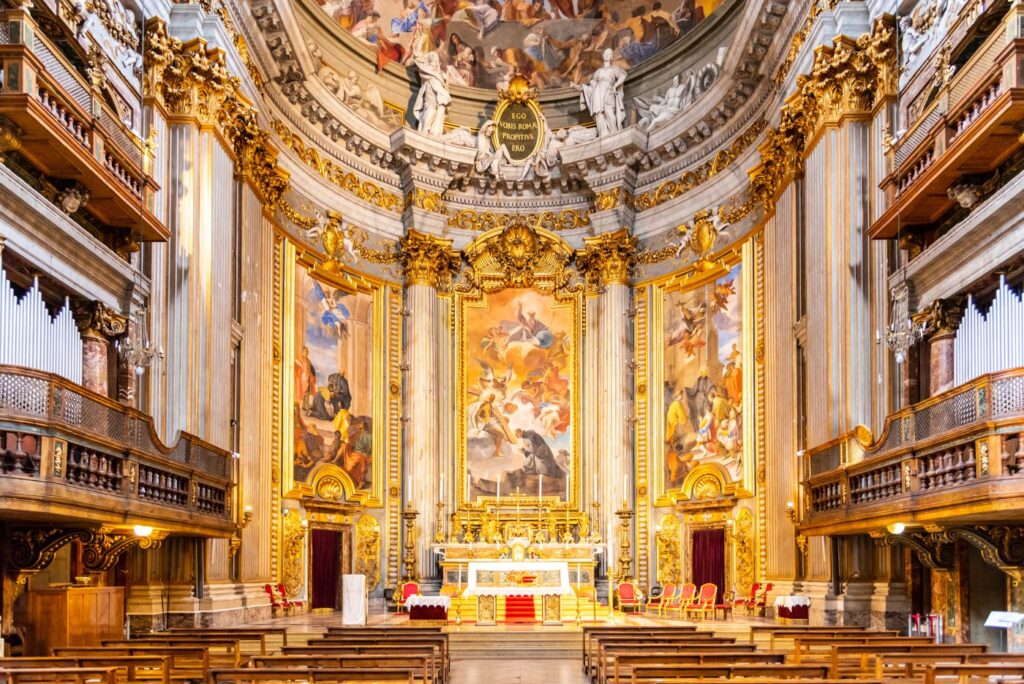The liberal triumph over modern totalitarian ideologies at the end of the twentieth century was striking in its final suddenness. But it was also ambiguous, in that it was quickly followed both by renewed theoretical doubts about the liberal project, and a new series of practical challenges in the durable phenomena of nationalism and religious politics, especially in the Islamic world.
Kevin Vallier’s overriding aim is to defend liberalism, and he is particularly concerned with responding to the religious challenges to it. His choice of Catholic neo-integralists as the subject of his book All the Kingdoms of the World: On Radical Religious Alternatives to Liberalism may seem curious, since they are hardly the most pressing threat to liberalism. However, he treats neo-integralism as a subtype of radical religious anti-liberalism and suggests analogies to other types in the book’s last chapter.
Some of his arguments are of particular relevance to Roman Catholicism; others are more generic. He is conscientious, thorough, and serious about his opponents’ views, but for reasons I will explain below, I doubt very much that his criticisms will persuade those he most wishes to persuade; nor are they the sorts of arguments that are most relevant from a specifically Christian perspective. Nevertheless, they are serious and deserve a hearing.
Vallier makes an initial methodological decision to characterize neo-integralism based mainly on the published writings of two thinkers: he takes King’s College London philosopher Thomas Pink as the principal theorist of neo-integralism and Harvard legal scholar Adrian Vermeule as principal strategist. This choice is consequential, since there are several other neo-integralist writers and because much of their view has been developed and disseminated on various social media platforms. His basic characterization of Catholic integralism describes it as a “two polity” theory, according to which God directs the state to advance the natural common good of a community and the Church to advance the supernatural good of all baptized persons. The specifically integralist component of this characterization is that the Church may mandate state policies in the service of its own ends backed by civil penalties. This is a version of the older notion that the state should serve as the secular arm of ecclesiastical authority. By implication, Catholic integralism also holds that the Roman Catholic Church should be the legally established church of the community.
Start your day with Public Discourse
Sign up and get our daily essays sent straight to your inbox.Dismantling the Case for Integralism
Vallier devotes two chapters to explaining what he takes to be the two strongest arguments for integralism. The first argument is historical and rests on claims based on many aspects of the Catholic tradition, from medieval practices of sacred kingship, to propositions defended or condemned by Church councils, including Lateran IV and Trent, as well as by papal documents from Pius IX and Leo XIII. Leo’s notion in Immortale Dei (1885) of an analogy of ecclesiastical and civil power to the soul and body of a person is prominent here. While Vallier also reviews the seemingly changed view of the Church following Vatican II, especially its 1965 declaration on religious freedom, Dignitatis humanae, he concludes that the balance of evidence is favorable to integralism.
The second argument, which Vallier calls the “symmetry” argument, holds that if states should promote natural goods, they should also promote supernatural goods so that civic life is ordered by the whole good, the integral human good.
Having set out a case for neo-integralism based on history and symmetry, Vallier’s rejection of integralism is based on three arguments, each developed in a chapter: transition, stability, and justice. The transition argument holds that the means necessary to get us from the liberal polities of today to integralist polities would require actions that would themselves violate Catholic morality. Here, Vallier takes his cues from what Vermeule has called “integration from within.” This involves the formation of an integralist elite-in-waiting. Armed with establishment credentials, they take their places in the ruling class (especially in the agencies of the administrative state), wait for the inevitable final collapse of liberalism, and then begin asserting their authority for the sake of the true integral common good, hopefully leading to the establishment of an integralist order. Vallier holds that capturing and holding state power would require very heavy-handed coercive policies. The most interesting point Vallier makes here is that a successful integralist strategy would need to culminate not just in state capture, but Church capture, which may be even less likely, a point to which I’ll return.
Vallier’s “stability” argument holds that even the successful establishment of an integralist political order could not last. It would need to maintain a balance of grace to infuse political practice and an optimal level of coercion to make up for grace’s absence. Here he constructs a formal model that will, I suspect, leave most readers cold, but his basic point is clear enough: modern social life generates a diversity that presents any integralist political system with the unhappy alternative of fatal decay or increasing repression.
Finally, Vallier argues that a Catholic integralist state would be unjust in a very specific sense. Pink, in particular, has pressed an interpretation of Dignitatis humanae that, while denying the state any authority of its own to coerce religious belief or practice, did nothing (and could do nothing) to change Church teaching about its own right to coerce all baptized Christians to keep their baptismal commitments.
While the Church used the state to coerce on its behalf and on its authority (the doctrine of the secular arm), it has in more recent times abstained from that practice, but never renounced its own right to coerce. The Church, however, in some future integralist order, may, in Pink’s view, return to its former policy and call on the state to serve as a coercive instrument of ecclesiastical authority. Vallier holds that for this to work, baptism must constitute a “moral transformer” that licenses what would otherwise be illicit acts of coercion. This would be a particular problem not only in the case of baptized non-Catholics, but also people baptized as infants who later abandon their faith. Vallier, therefore, denies that baptism can be the right sort of moral transformer, holding that if coercion of the unbaptized is wrong, coercion of the unwillingly baptized is also wrong, and indeed of those who also simply change their religious beliefs.
Vallier’s reconstructed arguments from history and symmetry are eminently contestable on the ground that should matter most to believers: theology. The very character of integralism as a “two polity” theory is deeply problematic.
An Unconvincing Case
Vallier sets his arguments out clearly and carefully. The many points he makes about the difficulties of both establishing and maintaining an integralist order are cogent and worth making. However, I doubt they will convince many neo-integralists, many of whom seem mainly concerned with preserving an ideal, however unrealizable in practice.
Vermeule and others have urged that those skeptical that integralism could be established lack political imagination, and point to other consequential but unpredicted modern political events (the fall of communism, the election of Donald Trump). They are confident that liberalism is crumbling and hope to offer an alternative theory and strategy for building a postliberal order. Doubtless, they are insufficiently attentive to what the real consequences of a large-scale collapse of liberal political institutions would be and what forces would most likely fill the void.
Be that as it may, I think the most serious problems with neo-integralism are other than those most discussed by Vallier. One serious consideration that he does mention, but that seems to me to deserve even more attention, is that before the neo-integralists convert the political community they must convert the Church. The Roman Catholic Church is deeply institutional and hierarchical; people who know nothing else about Catholicism know that there are authoritative doctrines and a sacramental priesthood, bishops, and a pope. Vallier quite rightly notes that Catholicism has 5,600 bishops from nations and cultures worldwide, and none openly affirms integralism. No pope has embraced integralism since Pius X (in office 1903–1914). The vast majority of Catholic theologians and leaders follow Dignitatis humanae’s standard interpretation.
At one point, Vallier archly refers to the neo-integralists as “a digital clique in search of political power.” This point needs to be emphasized: there is no support for integralism in the Church at large. It is mostly confined to discussions among (mostly young) Catholics on social media platforms.
But there is something more important still. Vallier’s reconstructed arguments from history and symmetry are eminently contestable on the ground that should matter most to believers: theology. The very character of integralism as a “two polity” theory is deeply problematic.
Starting where Vallier does in formulating his historical argument, Pope Gelasius I did not characterize Church and state as two polities, but one as an “authority” (auctoritas) and one as a “power” (potestas); later thinkers referred to two potestates. Much of nineteenth-century integralism was predicated on a particular theology of the Church, an ecclesiology, developed in response to the Reformation and the French Revolution, that aimed to defend the authority and independence of the Church by conceiving it as a “perfect” or “complete society” (societas perfecta) on analogy with the state. Catholic theology has largely abandoned that ecclesiology as inadequate to the uniqueness of the Church. The Ressourcement movement in Catholic theology recovered currents of thought from the great thinkers of the patristic period as well as the Middle Ages and renewed Catholic theology in the middle part of the twentieth century. Yves Congar, Henri de Lubac (later a cardinal), Louis Bouyer, and Charles Journet (also a cardinal) all developed theologies of the Church that decisively influenced the teachings of the Second Vatican Council as well as the pontificates of John Paul II and Benedict XVI.
This shift was already underway when Pius XII stressed the identity of the Church as the Mystical Body of Christ in his 1943 encyclical Mystici corporis. The Second Vatican Council’s constitution on the Church, Lumen gentium, informed by Ressourcement ecclesiology, stressed especially a model of the Church as the People of God, but also models of the Church as communion and the Church as sacrament. Jacques Maritain and Journet both held that the medieval arrangement made sense at the time in part because of the feeble capacities of many polities and the relative institutional strength of the Church. But both held that the Church–polity relationship also gave rise to distinct pathologies, often resulting in injustice to persons and corruption and manipulation of the Church itself. Joseph Ratzinger went even further, holding that the medieval Church–polity synthesis was an error. He held to the ecclesiology that informed Vatican II, which he saw as a return to the sounder view of the early Church and the Gospel.
Vallier has done a valuable service by patiently pointing out all the moral and political problems entailed by any attempt to establish integralism. The most important problem with integralism, however, is less in its conception of the state than in its conception of the Church.
Image by pyty and licensed via Adobe Stock.













